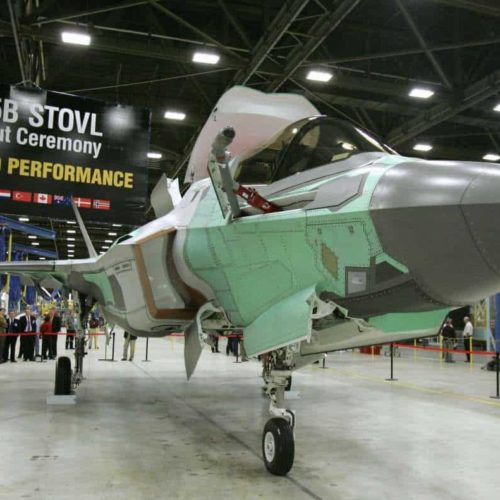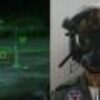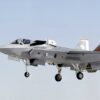Introduction
A little over five weeks ago, the Pentagon’s F-35 program got a new deputy manager, and a few days ago, he gave a candid “outsider’s” appraisal of the most costly weapons program in history — one that was noteworthy for its appraisal of how poorly the troubled aircraft program was run during the past decade and its criticism of the chaotic way that the Pentagon has been buying such high-tech weapons.
Maj. Gen. Christopher Bogdan, a seven-year Air Force acquisition veteran who last managed the KC-46 tanker program, warned an Air Force Association audience on Sept. 17 at National Harbor, Maryland, that “some of you may cringe at what I say.” Then he disclosed that the F-35’s buggy software “scares the heck out of me,” that its computer-driven logistics system is “frightening,” and that the relationship between the Air Force and the plane’s lead contractor Lockheed Martin is “the worst I’ve ever seen.”
The Pentagon intends to spend over $1.5 trillion over the next thirty years on the F-35, which it considers critical to the country’s military future. It’s a “joint” program because the plane is to be used by the Air Force, Navy, and Marines, an approach initially conceived to save costs. But Bogdan said that describing these as variants reflects a fundamental misunderstanding of what the effort has become: “It’s three separate airplane programs that have common avionics and a common engine.”
Not only that, the program has eight foreign partners and two foreign customers, a number the Pentagon hopes to grow. Partly as a result, its management has been a mess: Cost overruns so far have hit a billion dollars and production and flight testing are years behind schedule. In his 15-minute talk, Bogdan used the words “complex” or “complicated” 17 times, at one point asserting that “there is not a more complex program on the planet.”
Even after sixteen years of development and six years of production, the plane’s design remains a moving target. Bogdan said that “one of the things in the first five weeks that really shook me a little bit about this program is the amount of change that we allow….Change in any acquisition program is destabilizing and unsettling.” Affirming years of criticism by the Government Accountability Office, he said that allowing planes to be manufactured (32 so far) while it is still being designed is “the greatest of all sins in the Joint Strike Fighter Program.”
Simultaneously trying to design, produce and field the plane, while training new pilots and creating a parts-and-repair system has been a huge strain, Bogdan explained. “What program would you ever put on paper to do all those things at one time? You wouldn’t do it.” But he said the Pentagon is now stuck in its own mess, and called “concurrency” a “way of life for us” that’s “not going to go away.”
Bogdan expressed optimism that some of the plane’s legendary troubles are diminishing, but warned that the Air Force and the contractor are not measuring its progress by useful yardsticks. Lately, they’ve been boasting about passing key “test points,” accumulating more “flight hours” and achieving more “test sorties,” These don’t matter so much, Bogdan said, because the right standards are “more capability based….I’m not sure we’re measuring the right progress, but the test program is starting to create some momentum and that’s a good thing.”
He said a running dispute between the program’s management and the Pentagon’s director of test and evaluation over the scale and composition of the F-35 test program is no longer about substance, but about “where and when and who pays for it, quite frankly.” He also said that Lockheed, under heavy pressure from the Pentagon, had started to cut its production costs. “Are they coming down as fast as we want them to? No. But they’re coming down.”
But then Bogdan spoke candidly about engineering troubles that he said keep him “up at night.”
The largest of these is the software, now about three to four months behind schedule and still facing its steepest challenge: creating lines of code that fully integrate the fighter’s weapons systems with the plane’s operation. In anticipation, the software effort has been revamped, it’s gotten independent oversight, and the contractor has been barred from moving from one set of code to the next one without government approval.
“Until we have some time to see that really play out…we’ll withhold judgment as to whether or not it’s a touchdown or not,” he said.
Another major challenge is the jet’s complex helmet, a “Star Wars”-like device meant to project onto its visor how the plane is performing, where enemy targets are, and which weapons the pilot can use to handle them. As the Center reported in June, the display has been shaking so much it’s unreadable, and it also does not update swiftly enough. The helmet, Bogdan said, only works in “a very rudimentary way,” warning that uncertainties remain about whether it can be used at night, in bad weather, or in warfighting – the “basic” missions, as he put it.
If the problems can’t be fixed, or if an alternative ($80 million) helmet from Lockheed competitor BAE systems does not meet their needs, “then we have a big problem,” he said. “You don’t fly this airplane without a helmet.”
The new plane also cannot function without highly-sophisticated monitoring of its flight and repair history and the requisite programming of its missions. These are to be performed for each jet by something called the Autonomic Logistics Information System (ALIS). Bogdan said it answers these questions: “What parts do you need? What pilots are qualified? What maintainers are qualified? What mission plan is going?” In short, ALIS is meant to hold a trove of critical, militarily-sensitive data.
There’s just one major problem: The stream of data was found to contain security flaws. So the coding was rewritten, and is still undergoing testing. If ALIS doesn’t work, “this airplane doesn’t work,” Bogdan said. While a version might be functioning by November, the Pentagon has refused to accept some planes Lockheed built because they don’t have the fully functioning ALIS software.
Bogdan warned that both the Pentagon and Lockheed need to be told from now on that the F-35 managers will meet “your needs and not your wants.” He said the program can no longer expect unlimited injections of cash, noting the “great gift” that DOD gave his superior, Navy Vice Admiral Dave Venlet, in February, when it agreed to restructure the F-35 contract and add billions of dollars to its budget.
“There’s no more money and there’s no more time” coming for the program, “so… we’re going to have to do this in a disciplined way,” Bogdan said, adding that if changes can be made and long-term strategies worked out, “we’ve got a shot at getting this done,” he said. “We’ve got a shot. It will not be easy.”
Lockheed spokesman Michael Rein responded gamely to reporters that “it’s always good to have someone with a fresh set of eyes” looking at the program. “We remain committed to continuing our work to solve program challenges and build on the momentum and success we’ve achieved during the past couple of years,” he said in a Monday statement.
But he declined to discuss the sour relationship his company has with the Pentagon, something that Bogdan described as a “cultural thing” afflicting both sides.
Cheryl Irwin, a spokeswoman for the Office of the Secretary of Defense, told the Center that “there is broad agreement…with Major General Bogdan’s comments that the F-35 program will not succeed without strengthening the trust relationship between industry, stakeholders, and the government — across all aspects of the program.”
Newly-installed Air Force Chief of Staff Mark Welsh told reporters in a separate session at the AFA conference that the F-35 is one of three key programs for the Air Force. But he acknowledged that the price of the plane is still an issue. “We need the airplane, but the program’s got to perform,” said Welsh.
Read more in National Security
National Security
Documents show Air Force neglected concerns about F-22 pilot safety
A group of AF experts that started worrying about oxygen troubles ten years ago was disbanded for lack of funding





Join the conversation
Show Comments